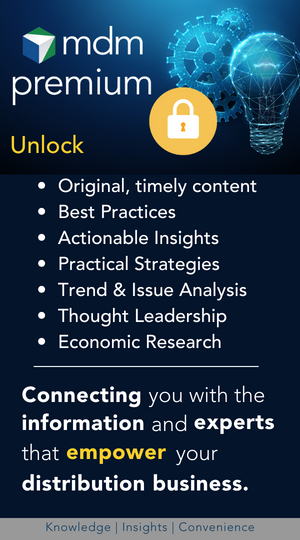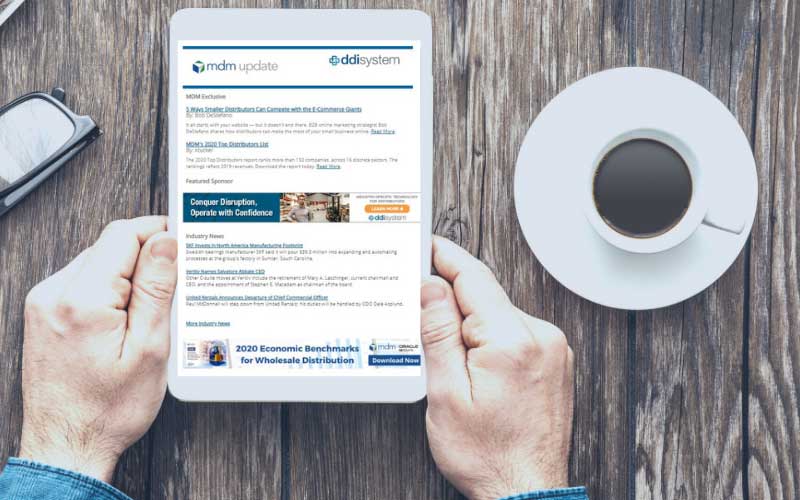MDM has syndicated MIT senior lecturer Jonathan Byrnes' blog focused on profitability management. Byrnes has worked with several businesses across industries, including distribution. MDM published a two-part interview with Byrnes in October 2010. He shares best practices based on his experience here.
I recently finished an interview with a journalist who is writing on the importance of supply chain optimization. This writer was addressing a set of distributors of products that have relatively low value for their weight and volume. This makes supply chain costs really critical to their profitability.
| We Deliver Distribution News to Your Inbox Sign up below to receive MDM Update, your free weekly distribution news update by email. |
As I thought about the topic, it struck me that there are two very different ways to approach the problem. The traditional way is to assess the software and automation possibilities that could be deployed, and then to think about ways to get the operating personnel to “buy into” the solution. I could visualize the usual checklists of software packages and capabilities.
Certainly, a number of terrific software packages and warehouse automation systems have been developed, tested and put into widespread use. But the real question is what to do with them.
In this slow economy, customers are minimizing their inventory, and increasingly depending on distributors for fast service. This enables strong distributors to increase business, but it also places a big cost burden on them. In the particular industry the journalist was writing about, this cost dynamic was having an extremely strong impact on profitability.
When I considered the deeper question of how to optimize this supply chain, three steps seemed especially important – steps that are all too often left out of the process.
First. Divide the business (logically) into core and non-core customers, and core and non-core products. Usually, your core customers and products are characterized by high-volume. If you think of this as a 2×2 matrix, each quadrant has very different characteristics, and each requires a different supply chain.
For example, core products for core customers should flow like a river from suppliers through distributors to customers, with minimal inventory (relative to sales) and minimized handling. Think about how radically this differs from core products sold to occasional customers, or from non-core (sporadically-ordered) products even sold to core customers.
The most important initial step in optimizing a supply chain is to understand that the right supply chain solution (decision rules, inventory levels, physical process) for each quadrant can and should be very different.
Second. Work with your customers – especially your core customers. Many customers do not have a sophisticated knowledge of how to set inventory levels and reorder patterns. You can make a big difference in both your profitability and your customers’ profitability by helping them. This is especially critical in these difficult times.
I recall working with a major distributor a number of years ago to reduce supply chain costs. After a little investigation, we figured out that there were only three or four inventory/replenishment systems that the customers used, and that most customers did not know how to keep them set correctly. We created a small team that worked with the core customers to readjust their systems. After a month or two, the cost savings were surprisingly large.
Third. Get the sales reps involved. In most distribution businesses, the sales reps are the primary link to the customers. In my experience, sales reps in many companies have an overwhelming number of objectives, ranging from revenues to promotional programs to brand introductions to point-of-purchase displays. While some companies include gross margin in sales objectives, net profitability, per se, is almost never an objective.
In many distribution businesses, supply chain costs are a critical determinant of profitability. These costs can vary considerably from customer to customer and product to product. They are deductions from gross margin in profitability calculations, so a simple focus on gross margin eliminates a major source of profit improvement.
It is very important for the sales force to understand the profit impact of customer orders and other supply chain costs, and to be given a fairly simple program to selectively improve customer profitability. Here, creating a simple “red-yellow-green” color-coding designation can provide terrific results.
For a sales force to be productive, the reps must have at most 3–4 clearly understood objectives. Profitability maximization must be one of them.
All too often, managers instinctively reach first for technology solutions, focusing primarily on the selection and implementation processes. But the real profit impact comes from changing the business.
Jonathan Byrnes is a senior lecturer at MIT and author of the recent book, Islands of Profit in a Sea of Red Ink. He is president of Jonathan Byrnes & Co., a consulting company with which he has advised over 50 major companies, medical institutions and industry associations. Contact him at jlbyrnes@mit.edu.
Related: Inventory Management a Top Priority for Distributors


